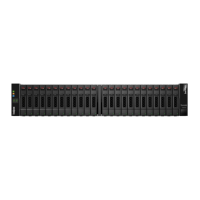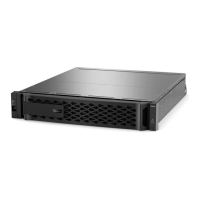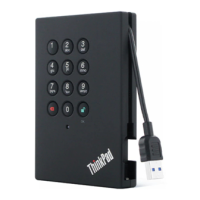◦ <ctlr_IP1> is the identifier of the controller.
◦
array_password is the password for the storage array. You must enclose the value for
array_password in double quotation marks ("").
◦
[trayID] is the identifier of the drive shelf that contains the drive drawer that you want to
replace. Drive shelf ID values are 0 to 99. You must enclose the value for trayID in square
brackets.
◦
[drawerID] is the identifier of the drive drawer that you want to replace. Drawer ID values
are 1 (top drawer) to 5 (bottom drawer). You must enclose the value for drawerID in square
brackets. This command ensures you can remove the top-most drawer in drive shelf 10:
SMcli <ctlr_IP1\> -p "safety-1" -c "set tray [10] drawer [1]
serviceAllowedIndicator=forceOnWarning;"
3.
Determine if you need to stop host I/O activity, as follows:
◦ If the command succeeds, you do not need to stop host I/O activity. All drives in the drawer
are in pools or volume groups with Drawer Loss Protection. Go to
Step 2: Remove cable
chains.
Possible damage to drives — Wait 30 seconds after the command
completes before you open the drive drawer. Waiting 30 seconds allows
the drives to spin down, which prevents possible damage to the
hardware.
◦ If a warning is displayed indicating that this command could not be completed, you must
stop host I/O activity before removing the drawer. The warning is displayed because one or
more drives in the affected drawer are in pools or volume groups without Drawer Loss
Protection. To avoid losing data, you must complete the next steps to stop host I/O activity
and to power off the drive shelf and the controller shelf.
4.
Ensure that no I/O operations are occurring between the storage array and all connected hosts.
For example, you can perform these steps:
◦ Stop all processes that involve the LUNs mapped from the storage to the hosts.
◦ Ensure that no applications are writing data to any LUNs mapped from the storage to the
hosts.
◦ Unmount all file systems associated with volumes on the array.
The exact steps to stop host I/O operations depend on the host operating
system and the configuration, which are beyond the scope of these
instructions. If you are not sure how to stop host I/O operations in your
environment, consider shutting down the host.
5.
If the storage array participates in a mirroring relationship, stop all host I/O operations on the
secondary storage array.
71

